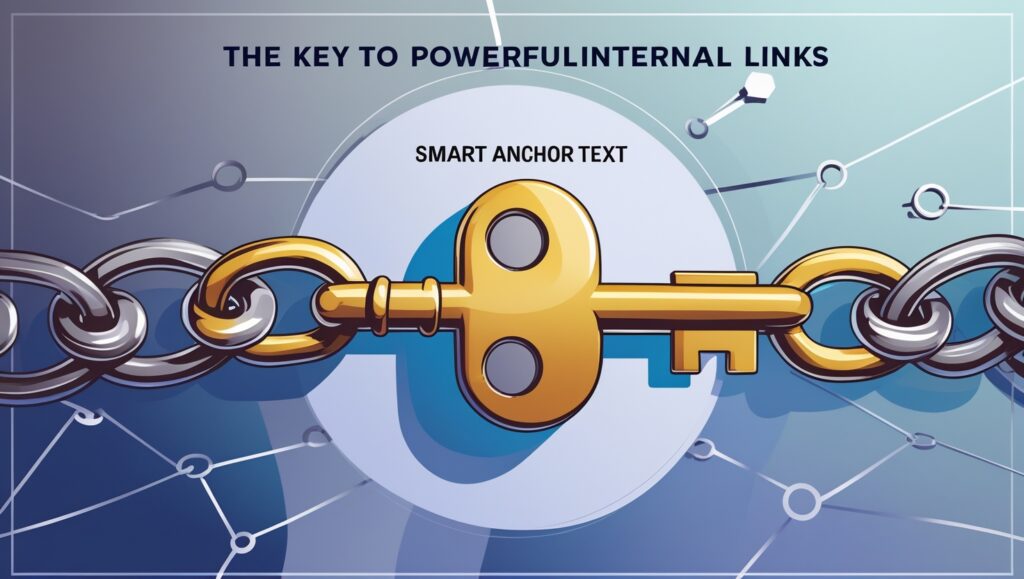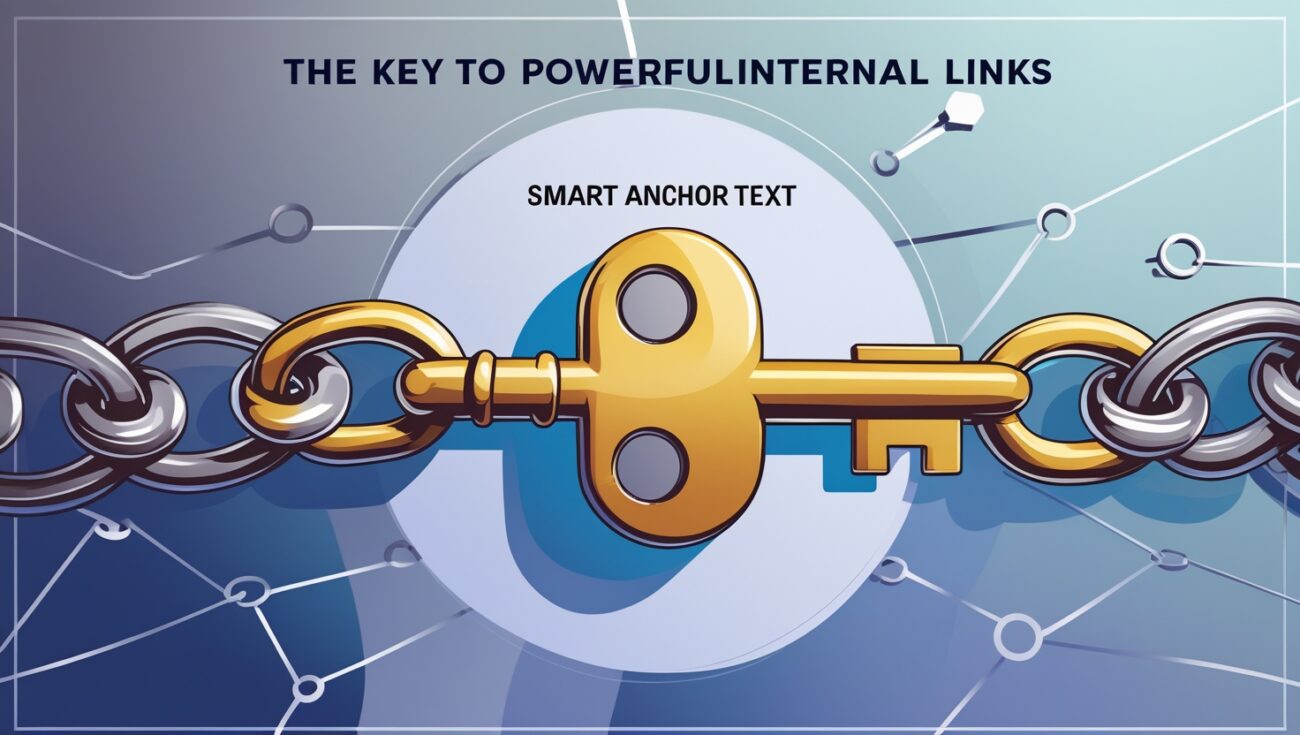Smart Anchor Text: The Key to Powerful Internal Links
We all know that internal links are important for SEO. We’ve been told they help pass link equity and improve crawlability. But after spending years optimizing my own websites, I’ve learned that the link itself is only half the story. The real secret weapon—the key to unlocking a truly powerful internal link—is the anchor text. The words you choose to make clickable are just as important as the pages you link to.

Table of Contents
I used to be guilty of using generic phrases like “read more” or “check it out.” I thought as long as a link was there, I was doing a good job. I was wrong. By understanding the psychology and SEO value of anchor text, I was able to transform my internal links from simple hyperlinks into powerful signals that improved my rankings and user experience at the same time.
What is Anchor Text and Why It’s More Than Just a Click
Anchor text is the visible, clickable text of a hyperlink. But its function goes far beyond just getting a click. It has a dual purpose that serves both humans and search engines.
- For the User: Anchor text sets the expectation for the user. It tells them exactly what they can expect to find on the other side of the link. A well-written, descriptive anchor text reduces friction and encourages a user to click because they know the link will be helpful.
- For Search Engines: Anchor text is a crucial ranking signal. When Google sees a link, it uses the anchor text to understand the topic of the destination page. A link with the anchor text “content marketing strategies” tells Google that the linked-to page is all about content marketing. This helps the destination page rank for relevant keywords.
The Types of Anchor Text (and How to Use Them)
- Exact Match: The anchor text is the exact keyword of the destination page. (e.g., a link to a page about “blue widgets” uses the anchor text “blue widgets“). Use these sparingly to avoid sounding spammy.
- Partial Match: The anchor text includes a variation of the keyword. (e.g., “learn more about blue widgets” or “our guide to blue widgets“). This is often the safest and most effective strategy.
- Branded: The anchor text uses a brand name. (e.g., “Linkbot“).
- Generic/Naked: These are phrases like “click here,” “read more,” or the URL itself. They provide no context and are a wasted opportunity. You should avoid these.
The Golden Rules for Smart Anchor Text
- Rule 1: Be Descriptive and Relevant: Always ask yourself: “What is this page about?” and then use words in your anchor text that reflect that. The words you use must be highly relevant to the destination content.
- Rule 2: Don’t Keyword Stuff: You can be descriptive without over-optimizing. Use natural language that fits the context of your sentence. A good anchor text should never feel forced.
- Rule 3: Avoid Generic Phrases: Every time you use a generic phrase like “click here” you are missing a valuable opportunity to signal relevance. A tool can help you audit your content and identify all of your generic anchor text.
- Rule 4: Look for Opportunities in Old Content: You don’t have to just create new links. Go back to your old, high-ranking content and look for opportunities to add new links with optimized anchor text to your newer, more important pages.
The Role of Automation in Mastering Anchor Text
Manually finding the best anchor text opportunities can feel impossible, especially on a large website. You would have to read every article, search for keywords, and then decide where to link. Automated internal linking software can analyze your content and provide a prioritized, actionable list of linking opportunities with suggested anchor text. It’s the ultimate hack for mastering anchor text at scale. If you want to start building a smarter internal link profile, I highly recommend exploring how Linkbot can help you.
Conclusion: Make Every Link Count
Internal linking isn’t just about the links; it’s about the words. By mastering the art of anchor text, you can transform your internal links from simple hyperlinks into powerful, descriptive signals that improve your SEO, your user experience, and your website’s overall authority. Stop wasting valuable opportunities. Start being intentional with every single word. Ready to create powerful internal links? Discover how Linkbot can help you optimize your anchor text today.
My journey taught me that a major mistake is seeing anchor text as just a visual element on a page. By focusing on the words I was using, I made the mental shift from a purely visual mindset to a strategic one. This allowed me to stop just adding links and to start building a purposeful, interconnected network that served both my users and my SEO goals.
The long-term, compounding effect of this quality-focused strategy is what makes it so powerful. Each time you add a thoughtful, relevant link with descriptive anchor text, you are not just performing a task; you are building your website’s authority, one word at a time. These small, consistent improvements add up to a significant competitive advantage over the long term, making your website an increasingly powerful asset.
I can say from personal experience that there is a special kind of satisfaction that comes from cleaning up a messy anchor text profile. It’s the feeling of taking a tangled mess of words and organizing them into a clean, logical network. The result is a website that just feels better to navigate, for both users and the people managing it.
A clean anchor text profile also has a huge impact on your website’s overall trustworthiness and authority. When a user or a search engine bot lands on your page and sees a clear network of interconnected, relevant articles, it signals that you are a serious, comprehensive resource on the topic. This kind of professional organization is exactly what Google looks for.
The most important part of this foundational skill is building a consistent habit of linking. It’s not about a single audit and then forgetting about it. A good website is a living thing, and it needs regular maintenance to ensure your internal links stay clean, which is a key part of long-term SEO success.
I felt like I was finally in the driver’s seat of my SEO. For years, I had relied on external factors, which felt like I was giving up control of my SEO destiny. But by mastering a simple task like auditing and fixing my anchor text, I was proactively building my site’s authority from the inside out, on my own terms, which was an empowering and exciting feeling.
By implementing a quality-focused linking strategy, you are also directly addressing Google’s E-E-A-T framework. You are demonstrating expertise by creating topical clusters, you are showing authority by linking from strong pages, and you are providing a better user experience, which is a key part of what Google looks for in a trustworthy website.
I’ll never forget the first time I applied my new anchor text strategy to a page that was struggling to rank, and it shot up in the search results almost overnight. This was my “aha” moment. I realized that a strategic, well-placed link from a high-authority page with descriptive anchor text was far more powerful than a dozen random, low-quality ones.
One of the greatest benefits I got from using an automated tool to manage my link profile was the “to-do” list it provided. Instead of being overwhelmed by the sheer size of my website, the tool gave me a prioritized, actionable list of fixes to make. It transformed a monumental, frustrating task into a series of manageable steps that I could tackle in just minutes.
It’s crucial to understand the difference between a simple, generic link and a link that’s part of a strategic, mapped plan. A simple link is a one-off connection. A link that’s part of a plan is a purposeful part of a larger network, designed to pass authority and guide a user. The latter is far more powerful.
Ultimately, mastering anchor text is a simple but powerful strategy that transforms a website’s foundation. It’s a low-cost, high-impact fix that can instantly improve your site’s health and SEO performance. It’s the kind of foundational SEO work that every website owner should prioritize.
My final piece of advice is to not be intimidated. Don’t worry about counting links; just focus on making your website a better place for your readers. You will be amazed at the progress you make and the results you can achieve.

